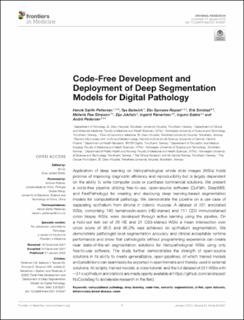| dc.contributor.author | Pettersen, Henrik P Sahlin | |
| dc.contributor.author | Belevich, Ilya | |
| dc.contributor.author | Røyset, Elin Synnøve | |
| dc.contributor.author | Smistad, Erik | |
| dc.contributor.author | Simpson, Melanie Rae | |
| dc.contributor.author | Jokitalo, Eija | |
| dc.contributor.author | Reinertsen, Ingerid | |
| dc.contributor.author | Bakke, Ingunn | |
| dc.contributor.author | Pedersen, André | |
| dc.date.accessioned | 2022-11-22T10:56:28Z | |
| dc.date.available | 2022-11-22T10:56:28Z | |
| dc.date.created | 2022-01-27T10:49:49Z | |
| dc.date.issued | 2022 | |
| dc.identifier.citation | Frontiers in medicine. 2022, 8, . | en_US |
| dc.identifier.issn | 2296-858X | |
| dc.identifier.uri | https://hdl.handle.net/11250/3033344 | |
| dc.description.abstract | Application of deep learning on histopathological whole slide images (WSIs) holds promise of improving diagnostic efficiency and reproducibility but is largely dependent on the ability to write computer code or purchase commercial solutions. We present a code-free pipeline utilizing free-to-use, open-source software (QuPath, DeepMIB, and FastPathology) for creating and deploying deep learning-based segmentation models for computational pathology. We demonstrate the pipeline on a use case of separating epithelium from stroma in colonic mucosa. A dataset of 251 annotated WSIs, comprising 140 hematoxylin-eosin (HE)-stained and 111 CD3 immunostained colon biopsy WSIs, were developed through active learning using the pipeline. On a hold-out test set of 36 HE and 21 CD3-stained WSIs a mean intersection over union score of 95.5 and 95.3% was achieved on epithelium segmentation. We demonstrate pathologist-level segmentation accuracy and clinical acceptable runtime performance and show that pathologists without programming experience can create near state-of-the-art segmentation solutions for histopathological WSIs using only free-to-use software. The study further demonstrates the strength of open-source solutions in its ability to create generalizable, open pipelines, of which trained models and predictions can seamlessly be exported in open formats and thereby used in external solutions. All scripts, trained models, a video tutorial, and the full dataset of 251 WSIs with ~31 k epithelium annotations are made openly available at https://github.com/andreped/NoCodeSeg to accelerate research in the field. | en_US |
| dc.description.abstract | Code-Free Development and Deployment of Deep Segmentation Models for Digital Pathology | en_US |
| dc.language.iso | eng | en_US |
| dc.publisher | Frontiers Media | en_US |
| dc.rights | Navngivelse 4.0 Internasjonal | * |
| dc.rights.uri | http://creativecommons.org/licenses/by/4.0/deed.no | * |
| dc.title | Code-Free Development and Deployment of Deep Segmentation Models for Digital Pathology | en_US |
| dc.title.alternative | Code-Free Development and Deployment of Deep Segmentation Models for Digital Pathology | en_US |
| dc.type | Peer reviewed | en_US |
| dc.type | Journal article | en_US |
| dc.description.version | publishedVersion | en_US |
| dc.source.volume | 8 | en_US |
| dc.source.journal | Frontiers in medicine | en_US |
| dc.identifier.doi | 10.3389/fmed.2021.816281 | |
| dc.identifier.cristin | 1991066 | |
| cristin.ispublished | true | |
| cristin.fulltext | original | |
| cristin.qualitycode | 1 | |

